Rehabilitated penguins
How you can support little penguins with The Helps Pōhatu conservation trust.
The back scene of adopting a penguin
2021 - January 18th by Geraldine
“How can I adopt a penguin? What does that mean? What do I need to do? How much will it cost me?” are probably some of the questions you might have in mind when looking at our “Adopt a Penguin” program… In this blog you will be able to have an insight into the back scene of your adoption. But let’s first assist you with your adoption process…

What is a penguin adoption?
First things first: I know it might seem obvious to most of all but “adopting” a penguin is actually a symbolic adoption. Penguins are wild animals so they need to live in their own environment, catch their own food and interact with their own kind as long as they are healthy enough to do so. Actually, unless penguins are hosted in a zoo (which is a different situation) or in rehabilitation for a short time (under a special permit) minimal interaction with human beings is best.
Then I am sorry to say you won’t be able to cuddle a cute penguin on your sofa… However, you are allowed to cuddle a penguin toy… No one will judge you for that J
Adopting a penguin in the Pohatu colony is like a sponsorship, a donation towards our Conservation charity “Helps Pohatu Conservation Trust” to help towards conservation costs.
Donations help cover a range of our conservation needs from:
- Nesting box materials for penguins and other native wildlife
- Penguin Rehabilitation: Penguin food, Vet bills, Rehabilitation facility maintenance.
- Predator control: Materials and maintenance, Trappers wage.
- Reforestation of Pōhatu’s covenants, Protected zones, Planting trees and track building.
- Research projects.
- Education for school groups.
- Staff training, e.g. Trapping workshops, Penguin symposium, Rehabilitation workshops.
In exchange, you will receive a photo of the nesting box with the name you have chosen on it - and with a bit of luck one of the penguins who lives in the nesting box - receive updates (on demand) and a newsletter at each season of you subscribe to it. Because you are donating to a registered charity, you will receive a tax rebate for your donation.
Basically “Adopt a penguin” allows you to give a huge help to endangered species from the comfort of your home!
What do I need to do to adopt a penguin?
On our website, click the “Adopt” button at the top of the home page. Alternatively, click on this link: https://www.pohatu.co.nz/Donation+-+Adopt+a+penguin.html
Once you are on the “Adopt” page you have the choice between 3 types of donation (see on the right side on the screen). Hover on the 3 different penguin drawings and it will explain what each donation involves.
If you live in or near Akaroa or passing by you can also pop in in our booking office and we can do it for you.
Choose your adoption pack: Digital or Snail Mail?
 Adopt a penguin - Digital Pack: you will receive everything by email
Adopt a penguin - Digital Pack: you will receive everything by email
- A thank you letter,
- A contribution certificate,
- A factsheet about little penguins,
- A poster of our Evening tour A4 to print if you wish
You can then decide to print the documents yourself or keep everything on your computer.
 Adopt a penguin - Snail Mail Pack: you will receive everything by post already printed for you + a couple of bonuses ;)
Adopt a penguin - Snail Mail Pack: you will receive everything by post already printed for you + a couple of bonuses ;)
- A thank you letter,
- A contribution certificate,
- A penguin activity booklet
- 2 factsheets about little penguins,
- A postcard of our Evening tour A4,
- A penguin sticker,
 Donation: This isn’t an adoption but allows you to donate the amount you choose towards the same conservation efforts from $1
Donation: This isn’t an adoption but allows you to donate the amount you choose towards the same conservation efforts from $1
Once you have decided on your Package, simply click the “Sponsor” button. This will lead you to our secured online booking System. Click on “Buy Now” then you will have to choose your option again.
How much will it cost me?
You can adopt a penguin from $85 with the Digital pack. The Snail Mail is a bit more expensive at $110 to cover the cost of printing and shipping. If you have already adopted, the Renewal costs you only $75.
You can also donate the amount to choose to help towards our conservation efforts from $1 (please note this isn’t an adoption)
Choosing a name for your penguin
Because you adopt a penguin in a specific nesting box in the colony, we display the name you have chosen on the box.
Before finalising your adoption, you can already provide us with the chosen name for your penguin. This will allow you to receive the photo of your nesting box with the name displayed on it as soon as possible. Use the “Penguin Name” box. If you haven’t decided on the name at the time of the booking no problem, you can get back to us when you are ready. Maybe you would like someone else to choose (in the case of a Gift for someone – see below).
Once the name is chosen, you can get back to us by email: tours@pohatu.co.nz with your name and the booking reference number. The name will be displayed on a wooden tag screwed on the box just like the photo below.
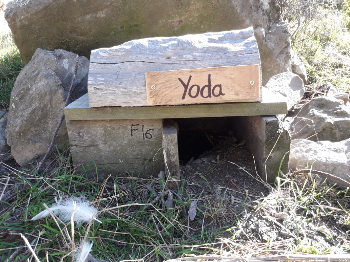
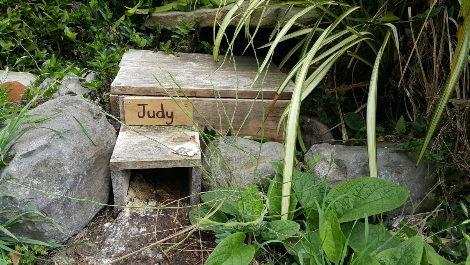
Please note that the name is for one penguin in the nest. Each nest can accommodate 2 adult penguins male/female. Examples of penguin names we have received in the past include: “Blue”, “Munchkin”, “Little Pengy”, “Puddles”, “Penny”, “Carter”, “Yoda”, “Aria”, “Guin Stefani”...
Adopting for someone else – Gift
It is becoming very popular to offer an adoption for a special occasion: Birthday, Anniversary, Christmas, Mother or Father’s Day… or just to be kind anytime in the year! Great for people who want a last-minute present as we can send everything (Digital Pack) within 48 hours. Please note that the photo with the label usually takes longer (can take a couple of weeks) for both packs.
In that case, tick the box “This is a gift for someone” then enter the giftee details. The certificate and thank you letter will be under the name of the giftee. The person paying the adoption will receive a separate letter with tax rebate on it.
Specify in the “Comments” box any details we need to know or a special message to the person that will be written on the “Thank you” letter.
For example: “Christmas present for my son. He will choose the name later…” "Happy Birthday to you Jerry!"
Important advice:
“Snail Mail” Pack: If you want to make sure you get everything on time for a present, please allow a minimum of 4 weeks for the pack to arrive at destination especially if you live oversea. And especially around Christmas time!
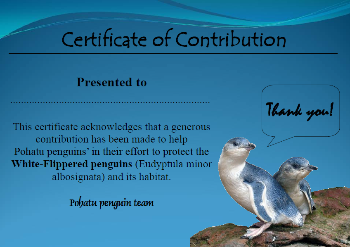
Everything is in our hands now!
Your adoption is now complete! Congratulations, you now belong to the family of Pohatu Penguins’ donors!
As soon as we receive the name for your adopted nesting box, we create a wooden tag. Then, one of our guides will go in Pohatu/Flea Bay to choose a nesting box in the colony and put the label on.
We will send updates on the whole penguin colony and our conservation work at different times of the year. To get updates on your own penguin, you can email us at any time and just ask!
Remember to use the link we send you by email to subscribe to the newsletter, this will allow you to receive 4 updates per year on the colony with photos and little stories...
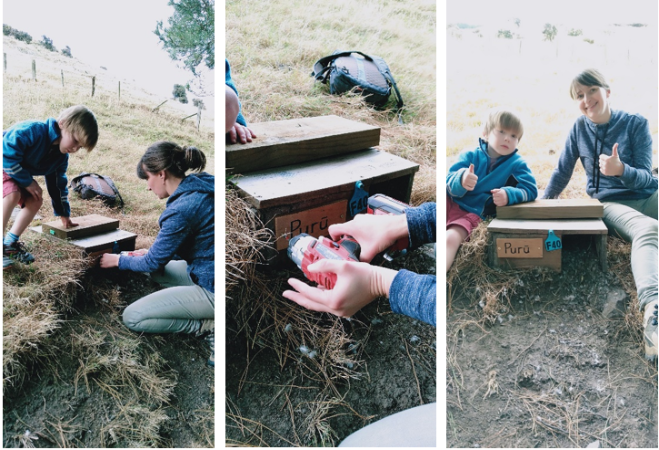

Labels ready to be fixed on boxes
Things to know:
- The adopted nesting boxes are built by the Helps family, the Pohatu Penguin’s staff along with the help of local schools, visitors, volunteers... These boxes provide nesting opportunities for the penguins to breed successfully as otherwise they tend to compete and fight over nests which can end up in breeding failures.
- We have around 250 artificial boxes, along with about 950 nests in the bay but not all boxes are occupied. Our conservation work includes the monitoring of about 200 boxes. We estimate around 85% of those boxes are occupied each year. Sometimes penguins take a year off breeding or sometimes they just don’t choose the box. We provide, they choose…
- An adoption lasts for a year. We will send you a reminder when your adoption is about to expire.
- Come and visit the colony. We would be more than happy to show you your nesting box if you can make it to us. Different options for that:
- Hop on one of our tour, all of them will take you to the penguin colony (30-45 mins drive from Akaroa). If you let us know before the start of the tour, we will make sure to take you to your nest. Some nesting boxes are very accessible and close to the homestead in Flea Bay, some are further away on the penguin track or uphill.
- At certain time of the year. If you have a 4WD and are confident driving on steep, narrow, gravel road then you can be in touch to book a self-drive tour (daytime or evening tour) and make your way to the bay. Once in Flea bay, a guide will take you around the penguin habitat, on the private land of the Helps family for a 45 mins tour during daytime or an Evening tour, about 1.5 hour, starting time to be confirmed a day prior. Please note that this allows you to come at a discounted price as you self-drive, you might be by yourself or join a small group tour. Need to be booked in advance as this is the only way to access the penguin colony.
Our best adopters and supporters
Getting children involved with endangered wildlife and conservation efforts is something we value a lot in our philosophy.
Since we started the “Adopt a penguin” program we have had the pleasure to communicate with wonderful young people dedicated to protect their world. We would like to honour these wonderful children in this blog and with their family permission we are sharing some of their best shots!
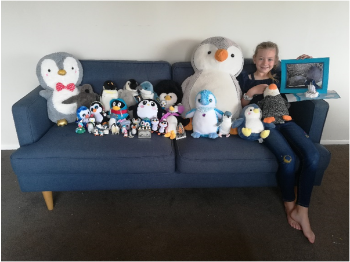
Daisy and her amazing penguins’ toy collection
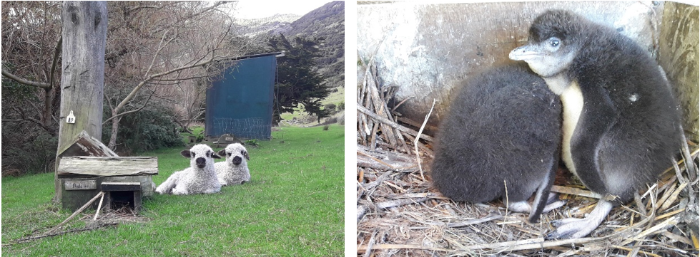
Daisy’s nesting box and the chicks “Puddles” well watched by the other inhabitants of the bay!

Sawyer and his family wearing their best tee-shirts!
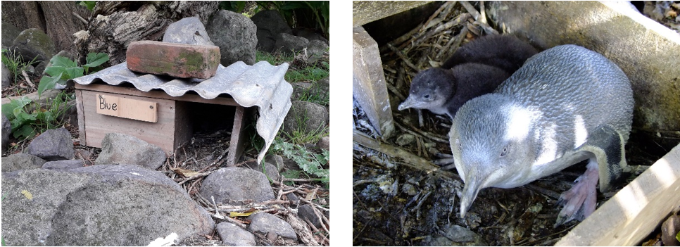


Sawyer’s nesting box “Blue” and its occupants
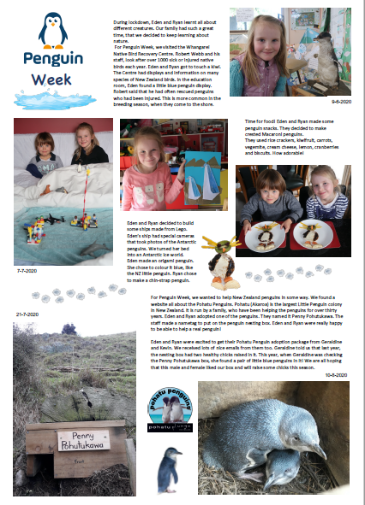
Eden & Ryan did a project around penguins with the support of their mum. They have adopted a nest in the Pohatu colony that they have named “Penny Pohutukawa”
They are sharing great ideas of activities with a penguin theme. Read their project by clicking on the link.
“Our children are the living messages we send to a future we will ever see...” Elijah Cummings
|
Ideally, we don’t want to handle our penguins at all. However, some of them need our help whether it be from an injury, illness or malnourishment. Pohatu Penguins steps in and gives these little birds a second chance at life! Most of our rehabilitated penguins are underweight or malnourished chicks. Typically, we find these chicks during our tours as we monitor the nesting sites. Why are the chicks malnourished/underweight?
What do you do in rehabilitation? This depends on the penguins needs and condition. Typically we will feed them 2-3 times a day depending on their weight and age. If they are old enough we will bring them for a swim in our “swim therapy pool”. Here, we introduce them to the water and determine if they are ready to be released. Injured or sick penguins will be sent to either a specialized penguin vet or dedicated specialists, Kristina and Thomas*, in Christchurch where they are assessed for future placement. Permanently injured penguins have the chance to live out their lives at the Antarctic Centre. *K&T Link: https://www.stuff.co.nz/environment/88518082/christchurch-couple-give-injured-rescue-penguins-the-full-pamper-treatment ParniaI spotted Parnia while kayaking; she was standing on the rocks looking extremely thin and weak. After getting back onto shore I quickly grabbed a bucket and went on to retrieve her – she gave little resistance to capture. Once I saw her up-close I realized that she had a deformed beak, probably why she had been so thin. (It’s very difficult for penguins to hunt efficiently with a crooked beak, most die.) I had never seen such a thin penguin and I expected her to die within the day, but still it was worth a shot to try and save her. Penguin band: P 41 087One year a starvation event happened right in the middle of the breeding season. When starvation occurs parents stop feeding their chicks to save themselves or only do so periodically. Chicks are then forced to leave (or fledge) the nest early in search of food. Unfortunately, chicks under 8 weeks old are not properly equipped to survive at sea and either starve or drown. In order to prevent early fledgings I fed the chicks while they remained in their burrows, hoping that the starvation event would end soon. Slowly but surely the parents started to return consistently feeding their youngsters and relieving me of my duties! Two years later P41 087 (we used to band our penguins) turned up in one of my breeding boxes. He was one of the largest, most beautiful penguins I had ever seen. P41 087 was evidence that my feedings, two years ago, had been a success. It warmed my heart to know that I helped save this little penguin and build him up for a healthy, successful life in the wild. He was my pride and joy. RoxyRoxy was handed in by the Fox II, a tourist sailing boat in Akaroa. She was extremely thin with a severe injury to her eye. Roxy looked like a recently fledged chick that seemed to have been hit by a boat. Her condition was very grim and I had my doubts about her survival.
However, to my delighted surprise she survived the first 24-hours, then the next and the next, and by day 3 she was on the road to recovery! Her eye injury, however, would be permanent and she would never be able to see from it again. Although, she was doing well in rehabilitation we knew that she wouldn’t stand a chance in the wild, thankfully, Roxy was also sent to the Antarctic Centre where she’ll live out a long and luxurious life! Shark baitThis is an all time favorite story that demonstrates incredible intelligence – intelligence you would never expect from a penguin. One night, while running an Evening Penguin Tour, we found a horribly injured penguin beside the track. I immediately took him into care and the next morning rushed him to Christchurch for an emergency veterinary assessment.. He had several shallow, flesh wounds and a lacerated leg. We suspected the culprit had been a shark. The vet stitched him up and I took him home to recover.. He spent a few weeks with us recovering and eating lots of fish – something he was quite happy to do through his moult*! Once his moult was complete we returned him to the sea and he happily shot off like a rocket! One year later, while running a tour, in the same spot on the tarck out in the open, we found a penguin near the track and out in the open we found a penguin that did move away from us as he should. He also did not attempt to bit and was very relaxed when I picked him up to examine him to find an explanation for this strange behaviour. He was in very good condition, but lame in one leg as Shark bait was when we released him. He proved beyond doubt who we was when I tried to feed him. He snapped and gulp the fish down gleefully and then looked for more, greedy as ever. As he was looking forward to another free easy loading molt we decided to indulged him and sent him on his way, fat and sleek once his feathers were grown in. Once again he shot off, instantly a wild penguin, but we did wonder, would he be back next year for another easy moult*? *Little Penguins moult – loose their old feathers and grow new ones – for two weeks every year. During the moult they cannot hunt and thus starve until it is complete. Yappy WiggleThis was the funniest penguin I’ve ever cared for! One day, while monitoring nesting sites I came across a burrow with one healthy chick and one very small runt. If one chick gets too far behind they simply die and the fouled nest can cause the healthy chick to become sick and die. The best option was to take the runty chick out, but then what to do with it? I decided I would simply throw it in the bushes. It’s very difficult to raise chicks that are less than 2 weeks old, especially if they are runts, but I thought I’d give it a go. Trying to feed such a young chick was not easy, but the little guy responded well and started to put on weight. Soon enough he turned into a healthy, respectable penguin. He became far too tame, however, and ran around like a puppy dog, wiggling his tail and begging for food with sharp, yapping noises. When it came time for him to leave he wasn’t exactly keen. On the first release he returned the next day yapping his way up the drive, begging for more fish. He had obviously not found any for himself. I allowed him to stay for a few days until I figured that we better try again; so, for a second time we released him back into the wild. He returned the very next day for more fish. I fed him once more and came up with a new idea, we’ll release him by kayak! So, in our third release, we took him by kayak to the entrance of Flea Bay and let him go. This seemed to be successful until the fifth day when we saw him hobbling towards the house. This time he was much weaker, thinner and a bit injured. I assumed he had hurt himself along the rocks and barnacles while exiting the sea. After our third try, we realized that Mr. Yappy Wiggle had imprinted on us and would not succeed in the wild. He now happily resides in the Antarctic Centre yapping and wiggling all over the place! Our Christmas Eve SagaBefore you read this you must understand: Yellow Eyed Penguins are the rarest penguin in the world and are extremely endangered. Every single one is precious. One Christmas Eve during a penguin tour we saw one of our Yellow Eyed Penguins drag itself ashore, obviously injured and bleeding. We caught the Yellow Eyed to gauge its injuries in which its feet were badly cut. It looked as though it kicked itself free from the jaws of life and escaped a near death shark attack. It needed stitching as soon as possible if it was to survive, but what vet would be open on Christmas Eve or Christmas Day? Talk about bad timing. I rang our closest vet in Little River and to my surprise he said to bring it straight over. This was 10.00pm on Christmas Eve. We arrived in Little River at 11.30pm, but the vet was nowhere to be seen. We sat there waiting and silently panicking over this precious penguin’s life. Until suddenly a vehicle pulls up with the vet and vet’s family! In order to successfully and painlessly stitch the penguin he needed to be put under. However, this can be dangerous if the penguin has a full stomach – something we weren’t sure about. We simply had to hope for the best and move forward with the procedure. The penguin did not fair well with the gas, he kept drifting in and out of conscious. Then, suddenly he started to heave and projectile vomit fish across the table, the floor and even the walls! Now, you can imagine our surprise, you can also imagine that it was quite unexpected and unfortunately we did not have time to react. So, like the table, the floor and the walls, we too were covered in fish vomit. Merry Christmas indeed! Thankfully after loosing its stomach contents our Yellow Eyed Penguin drifted into sleep and the vet was able to finish the job. With stitched and bandaged feet we placed our groggy penguin back into our vehicle. As we had to get the penguin home our vet and his family had to clean up the fish vomit – lucky them! We bid farewell and wished our Christmas heros a very Merry Christmas. After Christmas I sent the penguin to Christchurch to my wonderful friends and penguin rehab specialists, Christina and Thomas. Once it healed properly we released our Christmas penguin back into the wild. |
 Feeding chicks Feeding chicks Rehabilitated penguins in our garden going for a walk  Swim! (allow the penguins to oil up their feathers)  Releasing an adult.  Two chicks ready to go! (White flippered and Little Blue)  Trying to release Yappy Wiggle.  Still trying to release Yappy Wiggle...  Yellow Eyed Penguin with stitched foot.    |
|
These are just a few of the more memorable birds we have had in care. We rehabilitate many penguins, mostly Little Penguins, sometimes Yellow Eyed and occasionally a Crested Penguin. Most are sent off to sea successfully! If you too wish to help visit our Adopt a penguin page. |
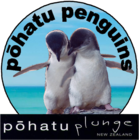

Comments